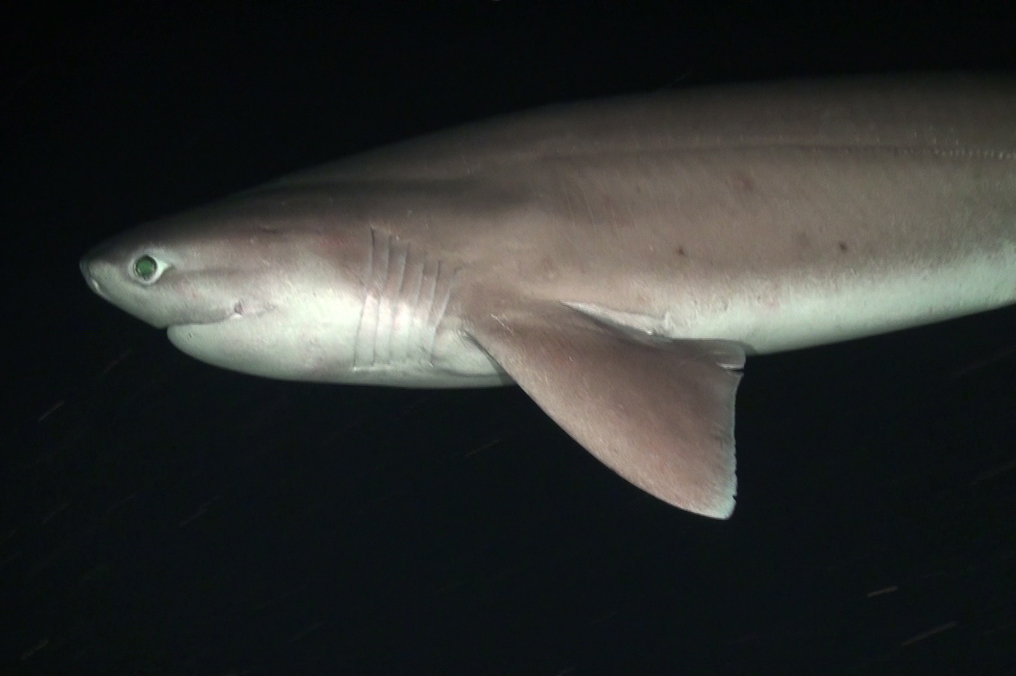Bluntnose Sixgill Shark, Hexanchus griseus (Bonnaterre 1788)

A Bluntnose Sixgill Shark, Hexanchus griseus, at Roque del Tío Millo, El Hierro, Canary Islands, Spain. Ranger Expedition to the Atlantic Seamounts, September 2014. Source: Oceana Europe / Flickr. License: All rights reserved
A large rather sluggish shark with a blunt rounded snout, six long gill slits on each side of the head, a single dorsal fin far back on the body near the tail, and six saw-like teeth on each side of the lower jaw. Bluntnose Sixgill Sharks is greyish-black to brown above, grading to greyish-white below, with white fin margins.
Bluntnose Sixgill Sharks in the Channel Islands National Marine Sanctuary off California, July 2012.
Video of a Bluntnose Sixgill Shark filmed at 140m in the southern Tyrrhenian Sea off Italy.
Another video of a Bluntnose Sixgill Shark in the Strait of Sicily off the coast of the volcanic island, Pantelleria, Italy.
A Bluntnose Sixgill Shark filmed at 1000m in Molokai, Hawaii.
Bluntnose Sixgill Shark, Hexanchus griseus (Bonnaterre 1788)
More Info
|
Distribution |
Off Queensland to west of Beachport, South Australia, and north-west Western Australia. Elsewhere. the species is widespread in boreal, temperate and tropical seas. Although individuals usually occur in deep water, they also enter bays near deepwater canyons. Juveniles often inhabit inshore waters. |
|
Feeding |
An apex predator and scavenger that feeds on a wide variety of prey including other sharks, skates and rays, bony fishes, and invertebrates such as squid, crabs, shrimps and sea cucumbers. |
|
Biology |
Reproduction is aplacental viviparous (ovoviviparous), meaning that the young hatch from eggs within the uterus of the mother. The pups are born live after a gestation period that may be as long as two years. |
|
Fisheries |
Taken mostly as a bycatch of commercial fisheries, and also as a sports fish. Overfishing has caused the decline of Bluntnose Sixgill Shark populations in some parts of the world. |
|
Remarks |
Bluntnose Sixgill Sharks undertake daily vertical migrations to the upper 200-300 metres at night, before descending to below 500 metres during the day. Research has shown that this species has a small amount of positive buoyancy, possibly enabling the Bluntnose Sixgill Shark to dive into very deep cold waters, and yet easily ascend to warmer waters at shallower depths (Nakamura et al. 2015). |
|
Species Citation |
Squalus griseus Bonnaterre 1788. Tableau Encyclopédique et Méthodique des trois Règnes de la Nature. Ichthyologie: 9. Type locality: France, northwestern Mediterranean Sea (as La Méditerranée) |
|
Author |
Dianne J. Bray |
|
Resources |
Bluntnose Sixgill Shark, Hexanchus griseus (Bonnaterre 1788)
References
Allen, G.R. 1997. Marine Fishes of Tropical Australia and South-east Asia. Perth : Western Australian Museum 292 pp. 106 pls.
Bonnaterre, J.P. 1788. Tableau Encyclopédique et Méthodique des trois Règnes de la Nature. Ichthyologie. Paris. pp. 1-215, 102 pls
Compagno, L.J.V. 1984. FAO Species Catalogue. Sharks of the World. An annotated and illustrated catalogue of shark species known to date. Hexanchiformes to Lamniformes. FAO Fisheries Synopsis No. 125. Rome : FAO Vol. 4(1) pp. 1-249.
Compagno, L.J.V., Dando, M. & Fowler, S. 2005. A Field Guide to the Sharks of the World. London : Collins 368 pp.
Compagno, L.J.V. & Niem, V.H. 1998. Hexanchidae, Echinorhinidae, Squalidae. pp. 1208-1232 in Carpenter, K.E. & Niem, V.H. (eds). The Living Marine Resources of the Western Central Pacific. FAO Species Identification Guide for Fisheries Purposes. Rome : FAO Vol. 2 687-1396 pp.
Comfort, C.M. & K.C. Weng. 2014. Vertical habitat and behaviour of the bluntnose sixgill shark in Hawaii. Deep Sea Research Part II: Topical Studies in Oceanography DOI: 10.1016/j.dsr2.2014.04.005
Cook, S.F. & Compagno, L. J.V. 2005. Hexanchus griseus. In: IUCN 2013. IUCN Red List of Threatened Species. Version 2013.2. <www.iucnredlist.org>. Downloaded on 22 January 2014.
Ebert, D.A. 1994. Diet of the sixgill shark Hexanchus griseus off southern Africa. South African Journal of Marine Science 14: 213-218.
Fowler, S.L., Cavanagh, R.D., Camhi, M., Burgess, G.H., Cailliet, G.M., Fordham, S.V., Simpfendorfer, C.A. & Musick, J.A. (comps and eds). 2005. Sharks, Rays and Chimaeras: The Status of the Chondrichthyan Fishes. Status Survey. pp. x + 461. IUCN/SSC Shark Specialist Group, IUCN, Gland, Switzerland and Cambridge, UK.
Gomon, M.F., Glover, C.J.M. & Kuiter, R.H. (eds) 1994. The Fishes of Australia's South Coast. Adelaide : State Printer 992 pp. 810 figs.
Kemp, N.R. 1978. Detailed comparisons of the dentitions of extant hexanchid sharks and tertiary hexanchid teeth from South Australia and Victoria, Australia (Selachii : Hexanchidae). Memoirs of the National Museum of Victoria, Melbourne 39: 61-83 figs 1-5 pls 12-15
Last, P.R., Scott, E.O.G. & Talbot, F.H. 1983. Fishes of Tasmania. Hobart : Tasmanian Fisheries Development Authority 563 pp. figs.
Last, P.R. & Stevens, J.D. 1994. Sharks and Rays of Australia. Canberra : CSIRO Australia 513 pp. 84 pls.
Last, P.R. & Stevens, J.D. 2009. Sharks and Rays of Australia. Collingwood : CSIRO Publishing Australia 2,550 pp.
Macbeth, W.G., Vandenberg, M. & Graham, K.J. 2008. Identifying Sharks and Rays; a Guide for Commercial Fishers. Sydney : New South Wales Department of Primary Industry, 71 pp.
Nakamura I, Meyer CG, Sato K (2015) Unexpected Positive Buoyancy in Deep Sea Sharks, Hexanchus griseus, and a Echinorhinus cookei. PLoS ONE 10(6): e0127667. Open access doi:10.1371/journal.pone.0127667
Regan, C.T. 1905. Note on Hexanchus griseus. Annals and Magazine of Natural History 7 16: 571-572.
Stead, D.G. 1963. Sharks and Rays of Australian Seas. Sydney : Angus & Robertson 211 pp. 63 figs.White, W. 2008. Shark Families Heterodontidae to Pristiophoridae. pp. 32-100 in Gomon. M.F., Bray, D.J. & Kuiter, R.H (eds). Fishes of Australia's Southern Coast. Sydney : Reed New Holland 928 pp.






